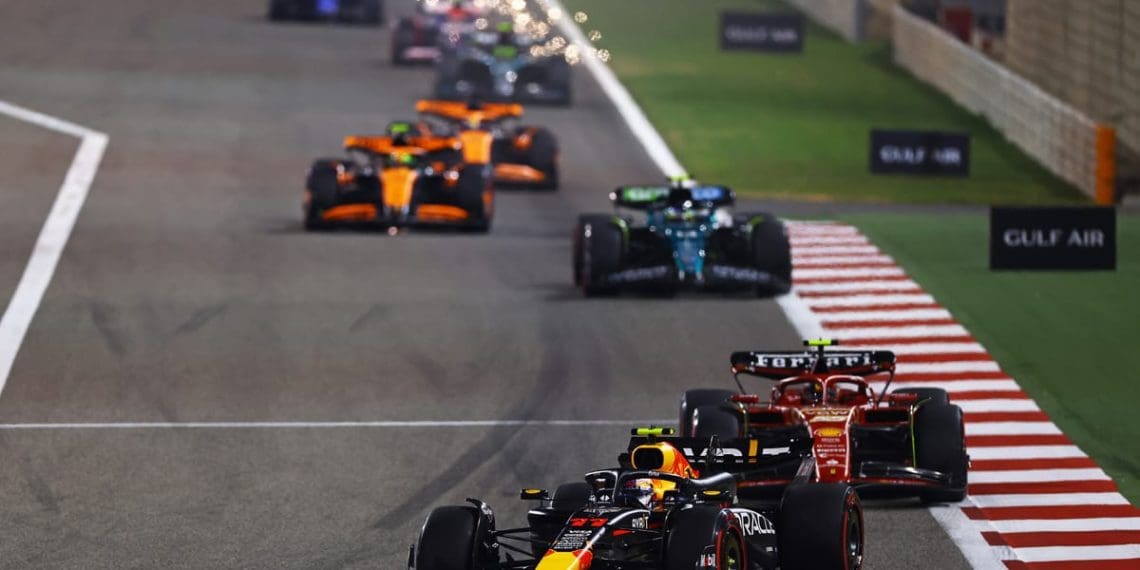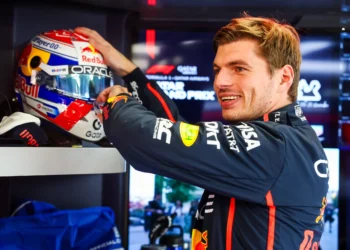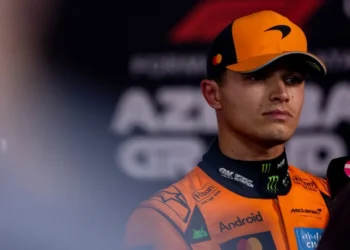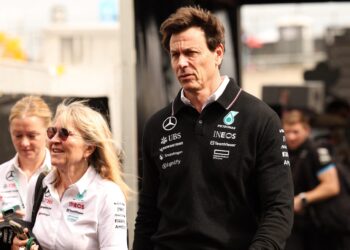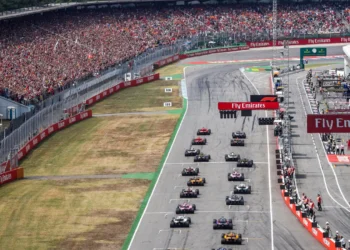The performance of Red Bull in the Bahrain Grand Prix indicates they are ready for another exceptional Formula 1 season. The qualifying session was more competitive, with Ferrari having the chance to secure pole position. However, a more detailed analysis of the data reveals further insights.
I delved into various team performance metrics, focusing specifically on year-on-year progress and disparities between single lap speed and race pace. While consistently beating Red Bull is challenging, putting pressure on them during qualifying can change the dynamics and lead to different strategic decisions from rival teams.
As the race got underway in Bahrain, Max Verstappen easily dominated, allowing him to relax and avoid any risks or hurried pit stops. Racing without pressure always makes things easier.
To get an overview of the teams’ progress since the introduction of the ground effect regulations in 2022, let’s take a closer look at the chart below. It provides a more revealing picture, showing that after three years, the returns from improvements are diminishing.
The chart illustrates the competitive order of the drivers based on their fastest laps of the weekend, comparing this performance to the average of the last six races of 2023. Verstappen came closest to a perfect score, with a difference of just 0.122%. To make a fair comparison, I took this percentage for all drivers and indicated their positions in parentheses.
This comparison considers only one event compared to the average of six events, so positions may change as the season progresses. However, the current rankings are quite unpredictable. Some teams faced challenges during the winter, both in terms of chassis and drivers.
Alpine, for example, clearly has a lot of work ahead, as indicated by their performance in the tests. To worsen their problems, technical director Matt Harman and aerodynamics chief Dirk de Beer have resigned from their positions.
By comparing the teams’ performance in Bahrain in 2024, 2023, and 2022, and converting it into a percentage of the fastest lap, we can determine which teams have made more progress under the current regulations. This analysis also allows us to evaluate the overall performance spread and how close the competition is.
This proves the old saying that if the regulations remain unchanged, the competition will become fiercer. The performance spread has decreased from about 2.5% in 2022 to 1.8% this year. Although the returns are diminishing, the pack is closing in.
Now, let’s examine which teams have made progress in terms of tire degradation since last year. The tire compounds remain the same, making the comparison fair. This can also indicate teams that have focused on optimizing their setups for the race.
To take this into account, I compared the qualifying positions with the finishing positions and noted the differences.
Now we can shift our focus from individual drivers to teams. By ranking them based on the performance of their lead drivers in qualifying and the race, we can assess their relative positions. This includes considering the time deficit and percentage difference.
Last year, all teams had at least one car finishing the race. This year, an impressive 20 cars crossed the finish line, marking a historic moment for Formula 1. This equality in qualifying and race positions suggests that, in terms of performance, the teams are where they should be.
To provide some hope, let’s compare the percentage difference between the team’s fastest lap of the 2024 weekend and the arrival time at the Grand Prix for the five teams that finished in the same lap as the leader. The rankings are based on the order of the fastest lap.
Although Charles Leclerc faced braking issues, resulting in lock-ups, his teammate Carlos Sainz had a relatively smooth race, finishing in third place. Ferrari has been working to improve its race performance, which has traditionally been weaker compared to qualifying. However, there is still room for improvement.
The pole position indicated that the Red Bull RB20 is fast on a single lap, but it could have easily been a front row for Ferrari. However, during the race, Red Bull proved to be in a league of its own. Verstappen’s fastest lap on new soft tires was only three seconds slower than his average lap for the race.
Mercedes’ qualifying session was decent, although there was a 0.225s difference between their drivers due to Lewis Hamilton’s mistake in turn 4. However, cooling issues hampered the team during the race, significantly impacting their competitiveness. This suggests that Mercedes did not properly address the cooling requirements, which is a negligence.
Despite the cooling problems, the mechanical platform of the Mercedes car seems to be working reasonably well. There were some issues with corner entry, but the rear provided the necessary stability for the drivers. If we disregard the time lost due to cooling management, the car could potentially compete with Ferrari, although it still falls short of Red Bull’s performance.
The performance of Aston Martin in qualifying did not stand out, but ended up being their strong point. However, during the race, they fought and had a performance similar to Haas last year. Aston Martin needs to closely examine their race pace.
McLaren may have left Bahrain relatively satisfied, but they need to find more pace both in qualifying and in the race to be considered one of the leading teams. They still struggle in slow corners and experience understeer in the middle of turns. However, we can expect McLaren to be stronger at other circuits.
The race deficit is the key number to consider. Just like last year, a close and competitive picture emerges when analyzing single lap pace. However, when it comes to race performance, Ferrari is approximately half a second per lap behind Red Bull.
While the chasing pack faced their individual problems, Red Bull also faced some challenges during the weekend. This suggests that the 2024 season may resemble the previous year, with Red Bull occasionally under pressure in qualifying, but dominating in race pace.
When the Red Bull RB20 was revealed, it instilled fear in its rivals, and the Bahrain race confirmed that they may be heading towards another dominant season.
© 2024
Portuguese drivers dominate the podium in the car racing competition
Portuguese drivers showed their talent and dominated the podium in this year’s thrilling car racing competition. With skill and determination, they secured the top positions, leaving their competitors behind. The crowd cheered with every overtaking maneuver and corner made by the Portuguese drivers, who once again proved their excellence in motorsport.
The great winner of the race was Pedro Silva, who crossed the finish line with an impressive lead. With flawless performance, he showed why he is considered one of the best drivers of his generation. In second place, we had Maria Santos, a young promise of Portuguese motorsport. At only 20 years old, she is already making her mark in the sport and promises a lot for the future.
In third place, we had João Costa, an experienced driver who did not disappoint his fans. With precise and strategic driving, he secured his place on the podium and showed that he still has a lot to offer to the world of racing. The three Portuguese drivers were applauded by the crowd, who recognized their talent and dedication.
In addition to the Portuguese drivers, other competitors also stood out in the race. Carlos Gonzalez, from Spain, finished in fourth place, showing that Spaniards also have skills behind the wheel. In fifth place, we had the Brazilian Rafael Santos, who impressed everyone with his speed and agility.
This year’s car racing competition was a true sports spectacle, with lots of excitement and adrenaline. The Portuguese drivers shone and showed the world the quality of motorsport in their country. Surely, we can expect great achievements from these talented drivers in the future. The next race promises to be even more exciting, with new challenges and surprises. Stay tuned for more news about the world of car racing.

